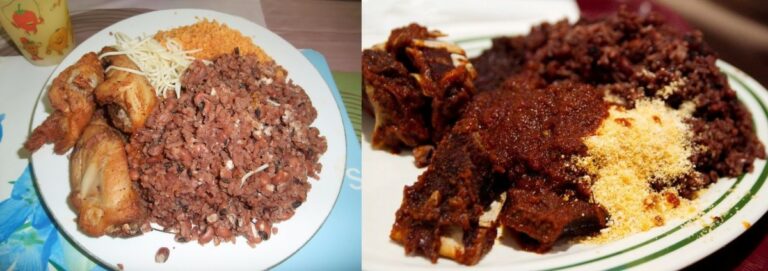Introduction: The Diversity of Ghanaian Cuisine
Ghanaian cuisine is a blend of traditional African and colonial European influences, resulting in a diverse culinary landscape. The country boasts a rich variety of ingredients, flavors, and cooking techniques, which vary depending on the region. From the north to the south, Ghanaian cuisine offers a world of flavors and textures that reflect the country’s cultural diversity.
Ghanaian cuisine is characterized by its use of vegetables, herbs, spices, and protein sources such as fish, meat, and beans. The staple foods of the Ghanaian diet are yam, cassava, plantain, rice, and maize. These ingredients are used to make a range of stews, soups, and sauces that are served with various types of meat, seafood, and vegetables.
Northern Ghanaian Cuisine: Unique Flavors and Ingredients
Northern Ghanaian cuisine is known for its unique flavors and ingredients. The region is predominantly Muslim, and as such, the cuisine is heavily influenced by Islamic dietary laws. The use of pork and alcohol is rare in this region, and lamb, goat, and beef are the preferred sources of meat.
One of the signature dishes of Northern Ghanaian cuisine is called “tuo zaafi,” a type of dumpling made from cooked maize or millet flour. It is served with soup made from vegetables, meat, and spices such as ginger, onion, and chili pepper. Another popular dish is “waakye,” a combination of rice and beans cooked with spices and served with stew or salad.
Coastal Ghanaian Cuisine: Seafood and Spices
Coastal Ghanaian cuisine is influenced by the country’s proximity to the sea. The cuisine features an abundance of seafood, including fish, crabs, and lobsters. The use of spices is also prevalent in this region, with dishes often featuring a combination of flavors such as ginger, garlic, and chili pepper.
One of the most popular dishes in this region is “jollof rice,” a rice dish cooked with tomato sauce, vegetables, and spices such as cumin, coriander, and thyme. Another popular dish is “banku and tilapia,” a dish made from fermented corn and cassava dough, served with grilled tilapia and a spicy sauce.
Ashanti Cuisine: Dishes Rich in History and Tradition
Ashanti cuisine is known for its rich history and tradition. The region is home to the Ashanti people, who have a strong culinary heritage. The cuisine is characterized by the use of spices, herbs, and vegetables to create complex and flavorful dishes.
One of the most iconic dishes in Ashanti cuisine is “fufu,” a starchy dough made from cassava, plantains, or yams. The dough is served with soup or stew, and the two are eaten together using the fingers. Another popular dish is “kontomire stew,” a soup made from cocoyam leaves and served with fish or meat.
Volta Cuisine: Vegetarian and Bean-Based Dishes
Volta cuisine is characterized by its focus on vegetarian and bean-based dishes. The region is home to the Ewe people, who have a strong culinary heritage. The cuisine is known for its use of spices, herbs, and vegetables, which are used to create complex and flavorful dishes.
One of the most popular dishes in Volta cuisine is “akple,” a type of dumpling made from fermented corn dough. It is served with soup or stew made from vegetables, meat, or fish. Another popular dish is “ademe,” a bean-based stew made from black-eyed peas, onions, and tomatoes.
Conclusion: Regional Specialties that Define Ghanaian Cuisine
In conclusion, Ghanaian cuisine offers a wide range of regional specialties that reflect the country’s cultural diversity. From the unique flavors and ingredients of Northern Ghanaian cuisine to the seafood and spices of Coastal Ghanaian cuisine, each region offers a unique culinary experience. Ashanti cuisine is rich in history and tradition, while Volta cuisine focuses on vegetarian and bean-based dishes. Together, these regional specialties define Ghanaian cuisine as a true reflection of the country’s cultural heritage.

